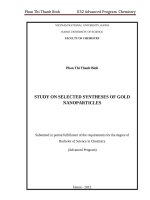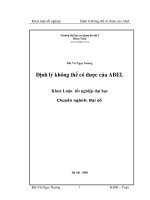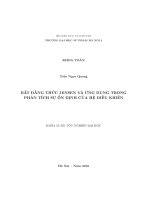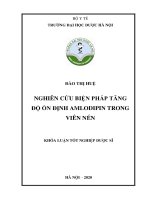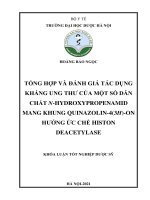Testing the effect of amomum subulatum extract on the larvae of pieris rapae (khóa luận tốt nghiệp)
Bạn đang xem bản rút gọn của tài liệu. Xem và tải ngay bản đầy đủ của tài liệu tại đây (1.82 MB, 45 trang )
VIETNAM NATIONAL UNIVERSITY OF AGRICULTURE
FACULTY OF BIOTEACHNOLOGY
GRADUATE THESIS
TESTING THE EFFECT OF AMOMUM SUBULATUM
EXTRACT ON THE LARVAE OF PIERIS RAPAE
Practicing Student
: Nguyen Dinh Thinh
Class
: K61-CNSHE
Tutor
: Dr. Dang Thi Thanh Tam
HA NOI - 2021
COMMITMENT
I hereby declare that this thesis is composed of my original works and
contains no material previously published or written by another person.
I commit that the references in the thesis are citied and all the help are
thanked.
Hanoi, January 28th 2021
Student
Nguyen Đinh Thinh
i
ACKNOWLEDGEMENTS
First and foremost, I have to express my appreciation and big thanks to
the the Director of Vietnam National University of Agriculture , Faculty board
and teachers in the Department of Plants Biotechology for creating an
interesting learning environment and providing me priceless knowledge through
five academic years.
During the time doing this thesis, many people helped me in bringing this
work to existence, especially my supervisor Dr. Dang Thi Thanh Tam, who
supported and inspired me to accomplish this thesis.Without her precious
support it would not possible tocomplete this thesis successfully.
I would like thank my partner Trinh Thi Huong Tra and all my friends ,
who were by my side to help and give me all best conditions.
Last but not least, I am also grateful to thank my parents for supporting
and encouraging me spiritually throughout my thesis and my life in general.
Hanoi, January 28th 2021
Student
Nguyen Đinh Thinh
ii
CONTENTS
COMMITMENT .................................................................................................... i
ACKNOWLEDGEMENTS .................................................................................. ii
CONTENTS ......................................................................................................... iii
LIST OF TABLES ................................................................................................ v
LIST OF FIGURE ................................................................................................ vi
PART I. INTRODUCTION ............................................................................... 1
1.1.
Introduction.. ............................................................................................ 1
1.2.
Aims ......................................................................................................... 3
1.3.
Objectives .................................................................................................. 3
PART II. LITERATURE REVIEW.................................................................. 4
2.1.
Overview of Pieris rapae ......................................................................... 4
2.1.1. Scientific Classification............................................................................ 4
2.1.2. Life Cycle of Pieris rapae ........................................................................ 5
2.1.3. The damage of Pieris rapae. .................................................................... 7
2.1.4. Some research on Pieris rapae ................................................................ 8
2.2.
Overview of Amomum subulatum plant ................................................. 11
2.2.1. Scientific Classification.......................................................................... 11
2.2.2. Morphological characteristics ................................................................ 12
2.2.3. Distribution and Habitat ......................................................................... 13
2.2.4. Benefits of Amomum subulatum plant ................................................... 14
PART III. MATERIALS AND METHODS ................................................... 16
3.1.
Location and time of the study ............................................................... 17
3.1.1. Location .................................................................................................. 17
3.1.2. Time of the the study .............................................................................. 17
3.2.
Materials ................................................................................................. 17
3.2.1. Research materials.................................................................................. 17
3.2.2. Instruments, chemicals and analytical equipment .................................. 17
iii
3.3.
Methods .................................................................................................. 18
3.3.1. Growing cabbage.................................................................................... 18
3.3.2. Pieris rapae culture ................................................................................ 19
3.3.3. Amomum subulatum extract preparation ................................................ 21
3.3.4. Experiments ............................................................................................ 23
PART IV. RESULTS AND DISCUSSIONS ................................................... 27
4.1.
Testing the toxicity of Amomum subulatum extract on Pieris rapae
larvae. ...................................................................................................... 27
4.2.
Testing the antifeeding effect of Amomum subulatum extract on P.
rapae larvae. ........................................................................................... 30
PART V. CONCLUSIONS AND SUGGESTION ......................................... 33
REFERENCE .................................................................................................... 34
APPENDICES ................................................................................................... 36
iv
LIST OF TABLES
Table 3.1. Diluting a starting stock solution to create solutions at various
concentrations ................................................................................... 21
Table 4.1. Mortality rate of larvae in the treatment with Amomum subulatum . 27
Table 4.2. Leaf consumption rate of larvae in the treatment with Amomum
subulatum .......................................................................................... 28
Table 4.3. Deterrency percentage of leaf consumption value of larvae after 24
hours .................................................................................................. 30
v
LIST OF FIGURE
Figure 2.1.
Life cycle of Pieris Rapae .............................................................. 5
Figure 2.2.
Young caterpillars of Pieris rapae were causing damage on
cabbage plants ................................................................................. 7
Figure 2.3.
Morphological characteristics of Amomum subulatum................. 12
Figure 2.4.
Amomum subulatum plants are grown in Vietnam (Ha Giang). ......... 13
Figure 3.1.
The process of growing cabbage .................................................. 18
Figure 3.2.
The process of Pieris rapae culture ............................................. 20
Figure 3.3.
The process of reparing for Amomum subulatum extract ............. 22
Figure 3.4.
The process of testing the toxicity of Amomum subulatum
extract ............................................................................................ 24
Figure 3.5.
The process of testing the antifeeding effect of Amomum
subulatum extract on P. rapae larvae ........................................... 26
Figure 4.1.
Mortality rate of larvae in the treatment with Amomum subulatum
after 48 hours ................................................................................ 28
Figure 4.2.
Experiment at initial time and after 48 hours ............................... 29
Figure 4.3.
The consumption area between control and treatment sample
at 0.5 % concentration of A.subulatum extract ............................. 26
Figure 4.4.
Control and treatment sample at initial time and after 24
hours at 0.5 % concentration of A.subulatum extract ................... 32
vi
PART I . INTRODUCTION
1.1. Introduction
In the past 30 years , scientists have been intensively investigated about
plant-derived extracts and phytochemicals with the main purpose was an effort
to develop alternatives to conventional insecticides with reduced environmental
impacts and protected people's heath. Synthetic insecticides can leave potentially
toxic residues in food products and be deleterious to non-target organisms.
Every year, the crop losses due to pests may reach 10–20%. In Vietnam,
the overuse of some chemical classes of insecticides has led to environmental
and human health problems.Synthetic chemical insecticides have many harm
that endangering human health and the environment such as effects on the health
of applicators, farmers, and even consumers; it accidentally kills wildlife
,beneficial insects, including pollinators and espiecial pollutes underground
water. From the drawbacks of chemical insecticides and their discontinued
manufacture have spurred scientist study and search for biological pesticides
with the ingredient that are found in products of natural origin. The botanicalbased pesticides often good for user, no harmful with other organisms.
Plantbased bio-pesticides are generally thought to be more selective, be less
harmful to nontarget organisms, degrade quickly, and be less phytotoxic.
Therefore, botanical insecticides may be effective for managing the small white
butterfly, Pieris rapae which is an important pest that affects cruciferous crops
worldwide. A single female lays 300 eggs on average, but clutches may include
close to 1000 eggs. Each young larvae occupies an outer leaf of a cabbage for
feeding. Older larvae move onto inner cabbage leaves and into cabbage heads by
eating outer leaves of the cabbage head and gnawing into it. Plants soiled with
excrement rot easily. In the world, some scientists have the study using plant
extracts to protect some of vegetables from larvae of Pieris rapae such as R. XU
et al.( 2008) performed a study about the control effects of pumpkin leaf extract
1
on caterpillars of the small cabbage butterfly and the result showed feeding
restrain, at concentration 1.4 g/l (0.98± 0.008) , 0.7 g/l (0.61± 0.026), 0.35 g/l
(0.41± 0.027) and 0.18 g/l (0.36± 0.022). In the presence of pumpkin extract,
feeding of larvae will decrease and the impact on crops will be limited. Beside ,
Hasheminia et al.(2013) conducted a study about effect of Milk Thistle, Silybium
marianum extract on the small white butterfly with toxicity tests and the result
showed that LC50 and LC25 values were 2.94% and 1.20%. With using plant
extract helped to reduce number of larvae of Pieris rapae that damaged the
plant.
In Vietnam, farmers used many ways to control larvae of Pieris rapae .
With manual ways, they used racket to catch butterfly and young caterpillar
beside they grown some types of plant that can be ability repel the butterfly.But
the most popular way ,they used chemical pesticides to kill young caterpillar
that would bring the active effects and effect quickly and in a timely manner. It
is this way of control P.rapae larvae of Vietnamese farmers, leading to harm to
human health, environmental pollution, and ecological impacts and with the
benefits pesticides of biological origin will bring us and the environment, I think
we should regularly use them. From the above bases, I always have the desire to
find new directions and especially it can be applied in Vietnam with the
following criteria easy to implement, cheap price, abundant raw materials and
high efficiency. I have learned and knowed that Amomum subulatum plants
were used for many different purposes, especially research on insecticide,
antibacterial (Satyal et al., 2012), antifungal and antioxidant activities ( Kapoor
et al., 2008). Besides Amomum subulatum plants are quite popular in Vietnam,
the price is quite cheap, easy to buy and convenient to use.
As a consequence, I want to find the plant extracts that have highly
effective insecticide on Pieris rapae. I decide to choose the subject: “Testing the
effect of Amomum subulatum extract on the control of larvae of Pieris rapae .
2
In this research, the toxicity and antifeeding effects of Amomum subulatum
extract on Pieris rapae were tested.
1.2. Aims
Testing the effect of Amomum subulatum extract on the control of larvae
of Pieris rapae.
1.3. Objectives
Testing the toxicity of Amomum subulatum extract on young caterpillars.
Testing the antifeeding effect of Amomum subulatum extract on young
caterpillars.
3
PART II. LITERATURE REVIEW
2.1. Overview of Pieris rapae
Pieris rapae is a small- to medium-sized butterfly species of the family
Pieridae. It is known in Europe as the small white, in North America as the
cabbage white or cabbage butterfly, on several continents as the small cabbage
white. This species is widely distributed throughout Europe, North Africa, Asia
and is a pest to crucifer crops such as cabbage, kale, bok choy and broccoli.
Pieris rapae is easily confused with other common cabbage white butterflies:
Pontia protodice, Pieris napi; and Ascia monuste (Shen et al., 2016).
2.1.1. Scientific Classification
Pieris rapae (Linnaeus) (Insecta: Lepidoptera: Pieridae)
Kingdom: Animalia
Phylum: Arthropoda
Class:
Order:
Insecta
Lepidoptera
Family: Pieridae
Genus:
Pieris
Species: P. Rapae
Binomial name: Pieris rapae
4
2.1.2. Life Cycle of Pieris rapae
Eggs of Pieris rapae
Larvae of Pieris rapae
Pupa of Pieris Rapae
Adult butterfly of Pieris Rapae
Figure 2.1. Life cycle of Pieris Rapae
Life Cycle of Pieris Rapae
The complete life cycle of Pieris rapae requires three to six weeks and
depending on weather. The number of generations reported annually are two to
three in Canada, three in the New England states, three to five in California, and
six to eight in Vietnam. Imported cabbageworm can be found throughout the
year in Vietnam and the most quantity at time from autum to winter when the
source food is plentiful (Shen et al., 2016).
Eggs: Eggs are laid singly, usually on the lower surface of outer leaves of
plants. The egg measures 0.5 mm in width and 1.0 mm in length, and initially is
5
pale white in color but eventually turns yellowish. They have shape is described
as resembling a bullet.
Larvae: The larva is green, velvety in appearance, and bears five pairs of
prolegs. The instar have five stages of ages.The body length are about 0.4, 0.6,
0.97, 1.5, and 2.2 cm, respectively. Body lengths at maturity of each instar
averages from 2 to 3 cm respectively. The larvae requires about 15 days (range
11 to 33 days) to complete its development. The best condition to develop at
20 - 24°C temperature and 75% - 85% humidity. A way to discriminte the first
instar with all larval stages don't have a narrow yellow line running along the
center of the back.
Pupa: Pupation normally appears on the food plant, but cabbageworm
may pupate everywhere are places that larvae can clingand nearly source food.
The pupa is about 18 to 20 mm in length, varies in color, usually yellow, gray,
green and speckled brown. At pupation, the chrysalis is anchored by the tip of
the abdomen to the silk pad and a strand of silk is loosely spun around the
thorax. In Vietnam they develop all season in year. The pupation is the
overwintering stage, however, its duration may be prolonged for months that
depend on temperature. The proportion of pupae that diapause increases as
winter progresses, so that at the time of the final generation all pupae are in
diapause as winter progresses so that at the time of the final generation all pupae
are in diapause.
Adult: Upon emergence from the pupa, the butterfly has a wing span of
about 4.5 to 6.5 cm. It is white above with black at the tips of the forewings. The
front wings are also marked with black dots, two in the central area of each
forewing in the female and one in case of males. When viewed from below, the
wings generally are yellowish and the black spots usually show faintly through
the wings. The hind wing of each sex also bears a black spot on the anterior
edge. The body of the butterfly is covered with dense hair which is colored
6
white in females but darker in males. The adult typically lives about three
weeks. The female produces 300 to 400 eggs. The adult is very active during the
daylight hours and often moving from the crop to flowering weeds to feed.
2.1.3. The damage of Pieris rapae.
Figure 2.2. Young caterpillars of Pieris rapae were causing damage on
cabbage plants
Larvae of Pieris rapae damage cruciferous crops by eating leaves, veins
and tips of plants. Young larvae hatch on the outer leaves and feed on them
superficially leaving the upper leaf surface intact. Older larvae make holes in the
leaves and are more likely to eat through small veins, they also damage the outer
leaves of the hearts of cabbages or the curd of broccoli or cauliflowers. They
often bore into the top of plant damaging the edible portion. Heavily infested
plants become ragged and stunted, leading to the plant can not growth and some
case can die. The presence of masses of wet greenish-brown excrement deep
among leaves is indicative of this pest ( Harcourt DG et al.,1962).
7
The caterpillar grow and cause heavy damage from October of the year
before to May next year, but the heaviest from February to May because the
weather at this time is suitable for growth and development of caterpillars.
2.1.4. Some research on the control of Pieris rapae by plant extracts
The production of plant-derived insecticides have prompted scientists to
find herbal plants that are resistant to insects.
Hasheminia et al.(2013) conducted a study about effect of Milk
Thistle,Silybium marianum extract on the small white butterfly, Pieris rapae.
They collected Milk-thistle S. marianum seeds,washed with distilled water, dried
and pulverized into a powder. 30 g of seed powder were mixed with 300 mL of
85% methanol in a flask for 1 hour and then incubated for 48 hours at 4°C. After
stirring for an additional hour and filtered through Whatman No. 4 fllter paper.
The solvent were romeved by vacuum in a rotary evaporator and dissolved the
residue in 10 mL of methanol. This was a starting stock solution was diluted
with methanol to create solutions at various concentrations. Toxicity tests,
preparing five concentrations of S. marianum extract 0.625%, 1.25%, 2.5%, 5%,
10% and a control sample (methanol treatment). All were used to test the
toxicity of the plant extract. 30 caterpillar at third stage were used for per
concentration of all the experiments. Each experiment was repeated three times.
Mortality was recorded at 48 hours and caculated the LC50 and LC25 values.
The result showed that LC50 and LC25 values for S. marianum were 2.94% and
1.20%. Besides deterrency tests were the tests to determine the leaf consumption
of young caterpillars. The treatment leaves were treated at 0.625% concentration
and compared with the control leaves after 24 hours. Two sections of cabbage
leaf of equal size were dipped in the desired concentration extract for 30 seconds
and then dried at room temperature. 10 larvae at third stage and all would
starved about 4 hours. After 4 hours starvation, larvae were placed on control
8
leaf and treated pieces of leaf ( placed in 15 × 30 cm plastic jars). After 24
hours, leaf consumption were calculated. The mean deterrency of 3rd instar
P.rapae larvae to leaves treated with the lowest dose (0.625%) of methanol
extract of S.marianum was 40.479 ± 5.23% compared to the control feeding
with methanol-treated leaves.
Elshaier et al.(2018) established a study about effect of some plant
extracts on the larvae of Pieris rapae. They used four plant extracts of vinca, ak,
neem and chinaberry. Leaves of vinca, ak, chinaberry plants and seed of neem
were collected, dried and then pulverized into a powder. Three solvent (hexane,
acetone and ethanol) were used to mix with powder of each plant and proportion
(1:1:1) about one week. The solvents were evaporated under reduced pressure,
the crude extracts were weighted and kept in deep freezer until use. This was a
starting stock solution was diluted to create solutions at various concentrations.
The desired concentrations of each extract were calculated on basis of the tested
plant weight and the volume of the distilled water (w/v) in the presence of tween
80 (0.1%) as emulsifier. Methods of application , cabbage leaves were dipped in
the tested concentration and dried under room temperature. Cabbage leaves were
treated at different concentrations from 500 to 15000 ppm. They used those
leaves for the third stage larvae to eat. Each concentration repeated 3 times.
Mortality was recorded daily for 7 days after treatment and this mortality was
calculated. They used only water and the emulsifier as a control. The results
showed that all four kinds of plant extracts caused larvae lethal at all
concentrations and the concentration of the extract was higher lead to the
mortality rate was higher. The mortality percentage recorded highest value in
case of ak leaves extract which was 93.33% at 10000 ppm and neem seed
extract recorded 86.67% at 10000 ppm. At 5000ppm concentration upwards of
all the plant extracts, mortality rate was over 60% at all experiments. In
conclusion, ak extract was the most toxic effect to young caterpillar of P. rapae
9
followed by extracts of neem, vinca and the last was chinaberry extract with
80% death lethal at the highest concentration.
R. XU et al.(2008) performed a study about the control effects of
pumpkin leaf extract on caterpillars of the small cabbage butterfly. They
collected 275 g of fresh, young leaves of Cucurbita ficifolia (pumpkin) and
immersed in 500 ml acetone after that mixed treated with ultrasound radiation
(250W) for 20 minutes. They used vacuum-filtration the acetone extracte and
removed the solvents under condition vacuum at<55 xC to obtain 23.2 g of dry
extract. When they taken experiment on the laboratory, they mixed 2.8 g dry
extract with water to creat a 1 litre constant volume emulsion. They would
shook this concentrated emulsion before using. Feeding restraint effect, they
used 30 fourth instar caterpillars. They placed caterpillars into a box and sealed.
The concentrated (2.8 g/l) PLAE was dilluted to four different concentration
1.40 g/l, 0.70 g/l, 0.35 g/l and 0.18 g/l and distilled water was used as a control
sample. They sprayed the solution on caterpillars until the filter paper
underneath caterpillars became wet. After 4 hours, all surviving caterpillars were
moved to humid. Petri dishes containing filter paper and one caterpillar was put
on per Petri dish. They used leaf discs of 20 mm diameter and five discs placed
into each Petri dish with one caterpillar per disc. Each concentration was
repeated ten times and calculated the leaf arae eaten by a leaf area meter. After
24 hours, the result showed feeding restrain at 1.4 g/l concentration was the
highest (0.98±0.008) and feeding restrain would decrease at a lower
concentration. At concentration 0.7 g/l (0.61± 0.026), 0.35 g/l (0.41± 0.027) and
0.18 g/l (0.36± 0.022). In conclusion, pumpkin leaf extract had the effect feeding
restrain on larvae of Pieris rapae at all concentrations.
Hasheminia et al.(2011) conducted a study the effects of Artemisia annua L
and Achillea millefolium L crude leaf extracts on the small cabbage butterfly
Pieris rapae. They collected the fresh leaves of Artemisia annua L and Achillea
10
millefolium L and then dried. They mixed 30g dried leaves with 300ml methanol
85% in flask adn stirred for 1 hour. The methanolic solution was incubated for
48 hours at 4°C, stirred for an additional hour and then filtered through
Whatman No. 4 filter paper. The solvent was removed by vacuum in a rotary
evaporator and the residue was dissolved in 10 ml methanol and used as a
starting stock solution. Toxicity tests were performed with five different
concentrations 0.625%, 1.25%, 2.5%, 5%, 10% and 3rd instar P. rapae larvae.
Mortality was recored after 24 hours and 48 hours to determine LC50 and
LC25 valuse. The result showed that after 48 hours, LC50 and LC25 values of
Artemisia annua L were
9.387% and 4.19%,
LC50 and LC25 values of
Achillea millefolium L were 3.645% and 1.69%. The toxicity of Achillea
millefolium L extract was higher. Deterrency tests to determine the leaf
consumption of caterpillars under the effect of the plant extract. The treatment
leaves were treated at 0.625% concentration of the plant extract and compared
with the control leaves after 24 hours. After 24 hours the result showed Achillea
millefolium L extract ( 44.185%) had antifeeding for larvae more than Artemisia
annua L extract (29.826%). Thus, extracts of Artemisia annua L and Achillea
millefolium L had the effect on larvae of Pieris rapae.
In Vietnam,the use of pesticides of biological origin
in the production of
agriculture is still limited so there are not many studies on the application of
plant extracts to control of Pieris rapae.
2.2. Overview of Amomum subulatum plant
2.2.1. Scientific Classification
Familia: Zingiberaceae
Subfamilia: Alpinioideae
Tribus: Alpinieae
Genus: Amomum
Species: Amomum subulatum
11
2.2.2. Morphological characteristics
Amomum subulatum plants
Flowers of Amomum subulatum
Seeds of Amomum subulatum
Fruits of Amomum subulatum
Figure 2.3. Morphological characteristics of Amomum subulatum
A.subulatum is a large perennial, evergreen. The plant consists of
subterranean rhizomes and several leafy shoots and spikes, that grow up 1.5 to
2.5 m of tall. The plant has several tillers consisting of pseudostems with leaves
and formed by long, sheath like stalks encircling one another. The plant will be
mature during the third year of its growth. Leaves are green, distichous, simple,
linear and lanceolate, glabrous on both side with prominent mid rib.
12
Inflorescence is a condensed spike ona short peduncle bearing 40 to 50 flower
buds in an acropetal sequence. The spikes are globose, very dense, and shortly
peduncled. The fruit are on an average 2 to 2.5 cm of long, oval to globose,
grayish brown to dark red brown and contain 40 to 50 seeds. Seeds are yellow
brown, sweet taste, slightly spicy aroma (V. K. Bisht et al .,2011).
2.2.3. Distribution and Habitat
Distribution :
A.subulatum plants are native to the sub-Himalayas, northeastern India
and Nepal. This plant also grows naturally in southwestern China.
In Vietnam, A.subulatum plants are widely grown in the provinces of Lao
Cai, Yen Bai, Ha Giang.
Figure 2.4. Amomum subulatum plants in Vietnam (Ha Giang).
Habitat
Amomum subulatum is a special shade-loving plant that loves moisture, so
it can only be planted under the forest canopy, with canopy 0.4 - 0.6 and at the
height of 1300 - 2200m.
13
Climate: It is suitable for cool and humid climate all year round, the
annual average temperature is 13 - 15.3°C, habitat often has the fog and annual
average rainfall of 3500 - 3800mm.
Evergreen plant all year round, the flower season starts from late April to
mid-May, fruits from May to September or October (Rao et a1.,1993).
2.2.4. Benefits of Amomum subulatum plant
Amomum subulatum plant has been used as preventive as well as a
curative
for
throat
trouble,
congestion
of
lungs,
inflammation
of
eyelids,digestive disorders and in the treatment of pulmonary tuberculosis . It is
also useful in treatment of flatulence, loss of appetite, gastric troubles,
congestion and liver complaints. Seeds and fruits of A.subulatum are added to
cooked food items as spices by the general population on a daily basis and can
play a preventive role in the occurrence of gastrointestinal disorders, respiratory
problems, through increasing palatability, flavor of foods make them more
digestible and serve to maintain good health (V. K. Bisht et al ., 2011).
In the world, scientists have many research and studies about Amomum
subulatum plant with the different purpose.
Satyal et al.(2012) conducted a study about chemical compositions and
biological activities of Amomum subulatum essential oils from Nepal had some
great success. They used hydrodistillation by Likens-Nickerson apparatus with
continuous extraction with CH2Cl2 for 4 hours to give clear reddishbrown
essential oils.
Antimicrobial screening : They used the microbroth dilution technique
and beginning with 50 µL of 1% w/w solutions
inhibitory
concentrations
(MICs)
against
the
to determine minimum
Gram-positive
bacteria,
Bacilluscereus (ATCC No. 14579) and Staphylococcus aureus (ATCC
No.29213); and Gram-negative bacteria, Pseudomonas aeruginosa (ATCC No.
27853) and Escherichia coli (ATCC No. 10798). The results showed minimum
14
inhibitory
concentrations
(MICs)
against
the
Gram-positive
bacteria,
Bacilluscereus (MIC = 625 and 313 µg/mL) and Staphylococcus aureus (MIC =
313 and 625 µg/mL). Beside with Gram-negative bacteria, both Pseudomonas
aeruginosa and Escherichia coli had a similar result MIC = 625 and 1250
µg/mL.
Insecticidal assays: they used two species are the fruit fly ( Drosophila
melanogaster Drosophila medium) and the red imported fire ant (Solenopsis
invicta×richteri). With the fruit fly, they used two concentration are 20 μL and
150 μL of A.subulatum essential oil(1%). Three vials were labeled as control
with volume 5-20 mm, the first containing only the fruit fly, the second with 20
μL of A.subulatum essential oil(1%), and the third with 150 μL of A.subulatum
essential oil (1%). Ten individual fruit flies weretransferred into each vial.
Surviving fruit flies were counted after 24 hours .With the red imported fire ant ,
they used 3 concentrations
1000 μg/ml, 500 μg/ml, and 250 μg/ml of
A.subulatum essential oil (1%). Each assay was carried out using a 400 ml
beaker, fitted with a filter paper disk on the bottom. The filter paper was sprayed
with 600 μl of sample solution and 20 fire ant workers were transferred to the
beaker. The beaker was sealed with Parafilm®. The mortality of fire ants was
recorded after 24 h and LC50 values were calculated. The oil was only
marginally toxic to the fire ant (LC50 = 1500 μg/ml), but moderately toxic the
fruit fly (LC50 = 341 and 441 μg/ml).
Dubey et al.(2008) performed a study about evaluation of Amomum
subulatum roxb oil as a source of botanical fungitoxicant for the protection of
mango fruits from fungal rotting .
The essential oil was isolated through hydrodistillation by Clevenger’s
apparatus and stored in glass vials after dehydrating with anhydrous sodium
sulphate. Determining the potency of A.subulatum oil in control of stem and
root of mango caused by B.theobromae, anthracnose, caused by C.
15
gloeosporioides, the mango fruits were treated with A. subulatum oil following
the technique of Sharma and Yadav(1996) and Dubey et al.(2008). They used
mature and healthy fresh mango fruits for the experiment. The fruits were
washed with running water and 0.1% sodium hypochlorite solution and then
washed with distilled water. A sterilized cork borer was used to produce a 5 mm
diameter injury on the outer surface of the mango fruit and then inoculated with
fungi (B. theobromae and C. gloeosporioides). The inoculated fruits were kept
in desiccators (five fruits per desiccator). In treatment sets, requisite amount of
A.subulatum oil was introduced into the desiccator by soaking it in a piece of
cotton so as to get a 500 ml/l (v/v) concentration of oil. The initiation of rotting
of fruits was observed. The result showed that the essential oil of A.subulatum
showed inhibition of enzymes pectinase and cellulase as it did not allow growth
of the test fungi in sets containing pectin and CMC. Pectinase and cellulase
enzymes produced by fruit rotting fungi play a prominent role in disease
development during hostpathogen interaction. The oil thus inhibits the test fungi
by acting on the enzymes related to an early stage of pathogenesis in the fruits.
This property of the A.subulatum oil proves its significance in checking the
initiation of rotting of the fruits due to macerating enzymes secreted by the
fungi.
16
PART III. MATERIALS AND METHODS
3.1. Location and time of the study
3.1.1. Location
Department of plant Biotachology – Faculty of Biotechology – Vietnam
National University of Agriculture.
3.1.2. Time of the the study
The research was conducted from 08/2020 to 03/2021
3.2. Materials
3.2.1. Research materials
Insect : Pieris rapae L. (Lepidoptera: Pieridae)
Plant : Amomum subulatum
Sources food of Pieris rapae :
Larvae : cabbage leaves
Adult butterflies : nectar and sirup
3.2.2. Instruments, chemicals and analytical equipment
Instruments :
The flask, petri, pipet, eppendorf tubes 1.5 ml, filter paper.
Analytical balance
Rotary vacuum evaporator
Magnetic stirrer
The box to feed lavae
Chemicals :
Methanol
Distilled water
Analytical equipment :
SPSS, GRAPHPAD
ImageJ software
Excel 2010
17
3.3. Methods
3.3.1. Growing cabbage
Cabbage seeds were used that were cabbage hybrid x2 of company Nong
Nghiep 1 company. Seeds were soaked in water for 8 hours, incubated for 24
hours at 35°C. Then the seeds planted in the ground. After 12 days, the seedlings
were transferred to pots. 40 seedlings were planted in the field, 300 seedlings
were planted in the green house. Cabbage were watered daily and fertilizer NPK
Dau Trau a times every 20 days. I did not use any kind of pesticides. Cabbage
leaves were used for feeding young caterpillars and experiments.
Cabbage seeds
Soaking seeds in water and
incubating for 24 hours
Cabbages in the greenhouse
after 70 days
Transferring the seedlings to
pots
Figure 3.1. The process of growing cabbage
18
